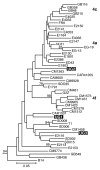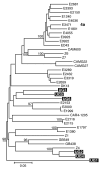Hepatitis C virus genotype 4 in Ugandan children and their mothers
- PMID: 17073099
- PMCID: PMC3294722
- DOI: 10.3201/eid1209.041068
Hepatitis C virus genotype 4 in Ugandan children and their mothers
Abstract
In Kampala, Uganda, in 2001, hepatitis C virus antibodies were found in 27 (4%) of 603 children and in 62 (12%) of 525 of their mothers. However, only approximately 10% of positive results were confirmed by reverse transcription-PCR, which suggests frequent false-positive results or viral clearance. All sequenced types were genotype 4.
Figures


References
-
- Tess BH, Levin A, Brubaker G, Shao J, Drummond JE, Alter HJ, et al. Seroprevalence of HCV in the general population of northeast Tanzania. Am J Trop Med Hyg. 2000;62:138–41. - PubMed
Publication types
MeSH terms
Substances
Associated data
- Actions
- Actions
- Actions
- Actions
- Actions
- Actions
- Actions
- Actions
- Actions
Grants and funding
LinkOut - more resources
Full Text Sources
Medical
Molecular Biology Databases
